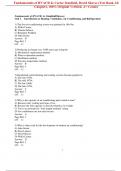Exam (elaborations)
Test Bank For Fundamentals of HVACR 4th Edition By Carter Stanfield, David Skaves (All Chapters, 100% Original Verified, A+ Grade)
Course
Fundamentals of HVACR 4e Carter Stanfield, David S
Institution
Fundamentals Of HVACR 4e Carter Stanfield, David S
Test Bank For Fundamentals of HVACR 4th Edition By Carter Stanfield, David Skaves (All Chapters, 100% Original Verified, A+ Grade)
Test Bank For Fundamentals of HVACR 4e By Carter Stanfield, David Skaves (All Chapters, 100% Original Verified, A+ Grade)
[Show more]
Preview 4 out of 709 pages
Uploaded on
January 30, 2024
Number of pages
709
Written in
2023/2024
Type
Exam (elaborations)
Contains
Questions & answers
free solutions manual answer key download
test bank download free test bank download
test bank exam bank mcqs solutions manual
Institution
Fundamentals of HVACR 4e Carter Stanfield, David S
Course
Fundamentals of HVACR 4e Carter Stanfield, David S
By: robertthibodeaux • 2 weeks ago
By: thesongstristmississippi • 3 months ago
Thank you so much!
$28.49
100% satisfaction guarantee
Immediately available after payment
Both online and in PDF
No strings attached
1 Copyright © 2022 Pearson Education, Inc. Fundamentals of HVAC/R, 4e (Stanfield/Skaves) Unit 1 Introduction to Heating, Ventilation, Air Conditioning, and Refrigeration 1) The first air -conditioning system was patented in 1844 by:




